 BioCycle September 2009, Vol. 50, No. 9, p. 16
BioCycle September 2009, Vol. 50, No. 9, p. 16
Sustainable packaging considerations for compostable products explored, including raw materials used in manufacturing. Part II
Rhodes Yepsen
Don’t subscribe to BioCycle?
Click here to download a free pdf of both parts of this article series.
COMPOSTABLE products are being touted around the world as a sustainable packaging solution, but there are several factors to consider. These include the source of the raw materials, energy consumed during manufacturing, and whether the products are actually captured for composting. Part I, “Compostable Products Go Mainstream,” in the July issue of BioCycle, profiled compostable product manufacturers in North America. Part II asks sustainable packaging experts about the pros and cons of compostable products, highlights a few positive examples, and then takes a closer look at the companies that produce the raw materials used to make compostable products.
The Sustainable Packaging Coalition (SPC) is an industry working group started by the nonprofit institute GreenBlue in 2004. “SPC endeavors to engage the entire packaging supply chain to shift the industry toward sustainable practices,” explains Martha Stevenson, Senior Project Manager at GreenBlue. “Participants include material manufacturers, packaging converters, consumer products companies, retailers and end-of-life handlers.”
The SPC has eight criteria in its definition. Sustainable packaging: Is beneficial, safe and healthy for individuals and communities throughout its life cycle; Meets market criteria for performance and cost; Is sourced, manufactured, transported, and recycled using renewable energy; Optimizes the use of renewable or recycled source materials; Is manufactured using clean production technologies and best practices; Is made from materials healthy in all probable end of life scenarios; Is physically designed to optimize materials and energy; Is effectively recovered and utilized in biological and/or industrial closed loop cycles.
“We acknowledge that they are very ambitious criteria, which is why it’s a vision for the future,” says Stevenson. “Nonetheless, when a company joins the SPC, it must commit to this vision. We do not focus on whether individual packages are ‘sustainable,’ but rather focus on the entire system being sustainable. There is sometimes a tendency to base sustainability claims on the choice of packaging material, but this myopic approach will not result in a truly sustainable system.”
For instance, although the Federal Trade Commission (FTC) has guidelines to prevent faulty marketing claims and greenwashing of products (see Part I in July), Stevenson argues that the current guidelines don’t go far enough. “A marketing claim should be supported by a standard, and in the case of recycling or composting, it should include clear instruction for the consumer. Currently, claims of ‘recyclability’ in the U.S. mean that the material is collected in a ‘majority of communities.’ Collection is not recycling and the variability of our waste management system can render such claims effectively meaningless.”
COFFEE CUP SUMMIT
As part of a grant through GreenBlue from the State of California, Stevenson is researching the information gap between the two ends of the packaging supply chain. She contends that part of the barrier to sustainable packaging is a lack of communication and understanding between those who design packaging and those who reprocess packaging into new products, either through recycling or composting.
In an effort to tackle that gap, Starbucks held a cup summit in May to bring together all facets of its hot and cold cup value chain, including raw materials suppliers, cup manufacturers and converters, peer retail and beverage partners, recyclers, local municipal governments, Starbucks partners (employees), environmental NGOs and experts from the academic sector. The company aims to develop a comprehensive solution that will make its cups recyclable or compostable in form and in practice by 2012.
Currently, there are regional discrepancies about what is recyclable or compostable, based in part on local processing capabilities. For instance, Starbucks cups can be recycled in Seattle and composted in San Francisco, but in many areas neither process is available. “As a company that operates in 50 countries and uses three billion cups per year, we’re committed to finding a solution that is scalable and sustainable,” says Jim Hanna, Director of Environmental Impact at Starbucks. “This will only be possible if we consider every aspect of the cup lifecycle and take the time to foster collaboration between our many stakeholders.”
Another facet is that most Starbucks cups leave the store with customers. “They’re taken to homes, office buildings, public parks and other venues,” Hanna says. “While evaluating our cup design and installing collection bins in our stores are important measures, it’s imperative that we also work with local municipalities to ensure an effective end-of-life infrastructure. Only then will we claim our cups are ‘recyclable’ or ‘compostable.'”
At the Starbucks cup summit, Jerry Bartlett of Cedar Grove Composting in Washington State explained that although properly designed packaging goes away in their piles, it doesn’t add nutritive value. “Compostable products associated with the food service industry make sense when they aid in the diversion of food waste to composting,” says Bartlett, Chief Environmental and Sustainability Officer at Cedar Grove. “But with other types of packaging, where you can separate them out, recycling those fibers and polymers is the highest and best use.”
Cedar Grove is known for its rigorous testing and approval of compostable products, which began in 2004, and recently launched a separate packaging sales group called Cedar Grove Packaging, LLC. The packaging group does not manufacture products, but is a collaborative business venture between the composter, food service distributors and manufacturers. In other words, they are bridging the communication gap that Stevenson describes. “Packaging companies did not understand the composting systems postconsumer food waste required, and Cedar Grove did not understand the complexities of packaging manufacturing and some of its limitations,” explains Susan Thoman, Director of Marketing and Business Development for Cedar Grove Composting. “Efforts to collaborate with the packaging community kicked into high gear in the Fall of 2008 when the City of Seattle prepared for its ban on expande polystyrene (EPS) in food service operations – in effect January 2009.”
A subsequent ban of nonrecyclable food service items will go into effect in the summer of 2010, continues Thoman. Cedar Grove Composting wants to minimize anticipated contamination when the packaging ban leads to replacement products. “With the new product line, acceptable products can be easily distinguished from unacceptable products that arrive at the composting plants,” says Thoman. “It also allows compostables to be included in curbside programs for the first time, since they are color marked consistently.”
Cedar Grove Packaging chose brown markings for its products. “Green was already being used by so many products that were ‘earth friendly,’ yet not necessarily compostable,” says Thoman. “In addition, food service suppliers pointed out that food did not look good on cool colors, and dark brown would be more aesthetically pleasing. Finally, the brown allowed minor residuals that might be left over after composting to blend better as a mulch.”
U.S. RESIN MANUFACTURING
Biodegradable resins and bioplastics are at the heart of compostable products. The manufacturers and compounders of these raw materials are on the ground floor of the compostable products industry. The rest of this article describes manufacturing processes and innovations, with an eye on sustainability.

NatureWorks, owned by Cargill, manufactures PLA resin under the brand name Ingeo, and has monitored the uptick in popularity of compostable products for mainstream food service companies, such as International Paper, Coca Cola, Solo Cup and Dixie. “These companies are tapping into composting as an alternative end-of-life for their products, but they are also looking at the lower carbon footprint of Ingeo,” says Brian Glasbrenner, Americas Business Director of NatureWorks. “In January, we brought a new technology online to reduce our carbon footprint. The fermentation step for turning dextrose into lactic acid is now more efficient, and further lowers our emissions.”
NatureWorks has extensively characterized the environmental impacts of manufacturing Ingeo, and had its work independently reviewed by UK lifecycle analysis expert Dr. Ian Boustead. The study includes fertilizers and fuel used for corn production, and also compares the production process of Ingeo in 2009 to 2005. From cradle to polymer factory gate, the improvements lowered greenhouse gas emissions from 2 kg CO2 equivalent/kg polymer, to 1.3 kg CO2e. To put that into perspective, emissions from Polypropylene production are 1.9 kg CO2e/kg polymer, and PET production releases 3.2 to 3.4 kg CO2e/kg polymer. Nonrenewable energy use for Ingeo was reduced from 50.2 MJ/kg polymer to 42.2 MJ/kg. In contrast, Polypropylene uses 73 MJ/kg, and PET uses 80.3 to 82.2 MJ/kg.
Due to growing demand for PLA, NatureWorks is expanding its production capacity. “NatureWorks is now producing close to 150 million pounds of Ingeo annually,” says Glasbrenner. “Our Blair, Nebraska manufacturing facility was constructed in 2002 with an annual capacity of 300 million pounds, but we only installed the first line of equipment. We are now installing the other line to reach full capacity, and are also looking at a second plant location.”
NatureWorks currently offers 15 different grades of Ingeo. “These are all PLA, and are all compostable, but their chemistry is tailored to fit various applications, such as flexible film, clamshell packaging, diapers, etc.,” explains Glasbrenner. “We work a lot with downstream manufacturers on innovations, such as with Frito Lay on the Sunchips bag being developed. They’ve publicly committed to offering a compostable bag by Earth Day 2010. This is a major brand adoption, lining up biobased supply and looking to reduce their ecological footprint.”

Cereplast has been producing biodegradable compounds since 2001, modifying properties of Ingeo such as heat deflection. “We develop blends that can be used on existing equipment, so that companies can optimize their system without redesigning the entire process,” says Philippe Ravera, Senior Vice-President of Marketing & Sales at Cereplast. “We have several major resins, all of which are compostable – for blown film, extrusion coating and foamed products. We’ve seen an increasing demand for non-food service compostable applications, like dental products, toys, packaging, agriculture, and cosmetics applications.”
Ravera describes how the basic heat properties of PLA were improved with biodegradable additives, but are still limited to 145° to 150°F. “That’s with the exception of extrusion coating, where a thin layer of resin is applied to a substrate like paperboard, and can therefore successfully hold hot beverages,” he says. “We’re hoping to have good performance with foamed resins, since they traditionally have slower heat transmission, making them a good insulation material.”
Cereplast recently announced two major products: “Cyclus margarine, made by the Brazilian company Bunge, launched a ‘No Trans Fat’ margarine in compostable tubs,” says Ravera. “Also, Dixie announced a compostable paper hot cup, lined with Cereplast resin.”

The new Dixie PLA cup was launched under the EcoSmart environmental product line, and BPI certified. “The compostable PLA hot cup is made from at least 95 percent renewable sources, and utilizes Ingeo PLA resin modified by Cereplast,” says Joseph Pounder, Director of Research and Development at Georgia-Pacific Professional, which owns Dixie. “All of our product development is built on a platform of sustainability, and we are finally at a point where the market and materials have reached commercial feasibility, at the appropriate cost structure.”
The compostable Dixie cup will be commercially available for food service customers in September, hot cup season. “Customers start placing orders for hot cups in September, to have inventory for the coming cold months,” says Pounder. “We started with the single-wall hot cup because it’s the simplest application. Depending on the market acceptance, we would consider extending the compostable coating option to other food service products, such as plates, bowls and other cups.”
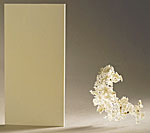
Telles, a joint partnership between Metabolix and Archer Daniels Midland, is another major U.S. manufacturer of biodegradable resin, called Mirel. “Mirel is a relatively new polymer to the market and Telles has, and continues to develop, new resin grades to meet customer requirements,” says Bob Findlen, Vice President of Sales and Marketing for Telles. “We have developed grades for injection molding and sheet, and are completing development in film, thermoforming, fiber and foam.”
Mirel is a polyhydroxyalkanoate, or PHA, and is produced through a microbial fermentation process. “This process makes PHA most similar to starches in biodegradation, meaning Mirel biodegrades in a broad variety of environments,” explains Findlen. “However, unlike PHA, starches are not performance materials that can compete with petroleum based plastics in physical properties.”
Mirel is biodegradable in soil, home and industrial composting systems, fresh water and marine environments. The major limiting factor for Mirel at this point is production capacity. A pilot plant produces 25,000 lbs/month, but the commercial facility, when complete, will produce 110 million lbs/year. “We are therefore currently focusing on business partnerships that allow us to develop product grades for Telles while developing applications that customers can take to market,” says Findlen. “These customers have included market leaders such as Target, Newell Rubbermaid, Ball Horticultural and Heritage Bag.”
INTERNATIONAL RESINS
In Europe, bioplastics magazine reports on new products, market trends and important events. “I’m confident that the market for compostable plastic products will continue to grow, especially where the compostability gives added value,” says Michael Thielen, publisher and editor of bioplastics. “Examples are the shopping bag that can be used later for a biowaste bag, e.g. to collect kitchen scraps for composting. Another example is vegetable or fruit packaging – when the produce is expired or spoilt at the point of sale, it can be disposed off together with the packaging into composting. Traditional plastic packaging has to be unwrapped first, and then disposed via the different waste streams. In a nutshell: the added value is important to justify the slightly higher prices for some of the compostable plastics.”
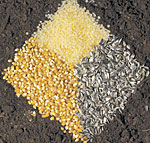
Novamont, an Italian company that manufactures the biodegradable resin Mater-Bi, is promoting organics diversion programs across Europe. Mater-Bi is biodegradable and compostable, and is used for applications such as bags, cutlery, food service products and packaging. Novamont is planning to reduce the environmental footprint of its facility, and reduce CO2 emissions by installing solar panels and using crop residues for renewable energy in the future.
“One of the most promising application we’re seeing is extrusion coating on paper, because the conventional counterparts are difficult to recycle,” says Christian Garaffa, Business Manager, Source Separation & Recycling for Novamont. “These products lined with polyethylene are extremely prevalent, and currently most of them are landfilled or incinerated. We also work with other suppliers and producers, to achieve a final result that is comparable to conventional packaging.”
Novamont allocated more than 10 percent of its revenues from 2008 to research and development. Besides extrusion coating and lamination, it is developing high barrier laminated structures that would be used on form fill seal (FFS) equipment. “Basically MaterBi is made of starch and biodegradable polyesters,” says Garaffa. “We’ve come a long way, and now new polyesters are being developed that contain increasing percentages of constituents made of renewable raw materials, such as sunflower oil, castor oil, etc. We initiated a joint venture a few years ago with a cooperative of 600 farmers to grow oil crops, and are now in a pilot stage for producing better quality oils for the monomers in Mater-Bi.”
However, Garaffa is quick to note that for compostable products, biobased content is secondary to performance. “It’s important to not lose focus of the whole lifecycle, and the end-of-life options,” he says. “This is essential when considering biobased content, but also the price of compostable products — you cannot compare the sticker prices of compostable products and conventional products. Although compostable products are more expensive, the advantage and value is in how they fit into a whole system, in terms of cost savings for the user, savings for the composter, and environmental benefits that everyone receives.”
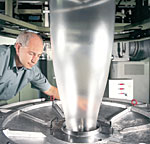
BASF is a German-based company that manufactures the biodegradable plastic EcoFlex. The largest chemical company in the world by sales, BASF is investing heavily in biobased and biodegradable plastics in the next few years, adding 60,000 tons of EcoFlex production and 15,000 tons of Ecovio (a compound) production in Europe by late 2010. “Bio-degradable polymer sales at BASF have experienced over a 20 percent growth rate during the last five years,” says Keith Edwards, North America Business Manager for BASF Bio-degradable Products. “That’s higher than a typical pace for new materials, but biodegradable plastics still represent an evolution in plastics, and in most cases volumes for bioplastics are still below 1 percent of the total global plastics demand.”
EcoFlex is made from fossil-based materials. “The monomers in EcoFlex are biodegradable on their own, and are chemically bonded in a way that nature can deal with,” explains Edwards. “Microbes don’t care where the carbon comes from or how old it is, so long as they can use the carbon in the structure. The fossilized carbon offers EcoFlex unique properties, compared to biobased materials. First of all, it is less susceptible to water attack, and therefore doesn’t have to be dried before production. Second, it is thermally stable up to 250°C, and capable of being re-melted and reprocessed like traditional thermoplastics.”
EcoFlex is a softer material with high elongation, but can be compounded to achieve a wide range of properties. For instance, BASF compounds it with PLA, which has higher rigidity, to create Ecovio. “The proportions of PLA to EcoFlex in Ecovio depend on the application, balancing tensile strength, elongation, rigidity, etc.” he continues. “We offer three basic grades of Ecovio, and are introducing a foam grade this Fall.”
The PLA gives Ecovio a biobased content, although BASF is also working on replacing one monomer in EcoFlex with a renewable based monomer. “We are currently testing this new version of EcoFlex, which would still be biodegradable and compostable, but would also be approximately 30 percent biobased.”
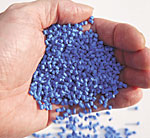
FkUR, another German company, is similar to Cereplast in that it compounds raw materials. Incorporated in 2003, it has developed two biodegradable plastics: BIO-FLEX, a PLA-based plastic used for extrusion, and BIOGRADE, a Cellulose Acetate (CA) based plastic for injection molding. “Generally, raw bioplastics such as starch, PLA, PHA, PBS and others, are not easy to use and are therefore blended and compounded into more functional materials,” says Christian Bonten, Director of Technology and Marketing at FKuR Kunststoff GmbH.
FkUR recently released a thermoformed foam product using BIO-FLEX. “A plank or thin plate is made by means of extrusion foaming,” explains Bonten. “In a second step, the plank is heated up again and thermoformed to the three dimensional product. For foaming you need a polymer with a special molecular weight distribution. This is not easy with biopolymers. On the one hand, the molecular weight must allow a certain softness for the expansion of the bubbles, on the other hand after expansion and cooling you need a stable foam structure.”
Bonten notes that in the last few years the supply of bioplastic resins has lagged behind demand, but with new production facilities coming on line, this should be solved in the near future. “We suffered from poor availability of these raw bioplastics like PLA, but once capacities are sufficient, we can all grow business rapidly,” he says. “The hardest work has already been done, with people becoming more and more aware of bioplastics and their benefits, and willing to pay a premium when there are appropriate waste avenues.”
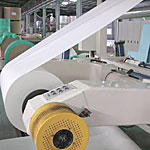
Wei Mon Industry is a Taiwanese company that makes Pland Paper, Ingeo-coated paper products. “We have been NatureWorks’ sole agent for Ingeo in Taiwan since 2002,” says Lilian Lai, Global Business Development Director for Wei Mon Industry Co., Ltd. “It was not an easy market promotion at first, when all the major players in plastic manufacturing industry were not supportive. However, as the restriction law on plastic in Taiwan was implemented, Wei Mon worked on forming a Joint Alliance Group, participated in by those willing to take the lead in the industry.”
Pland Paper means PLA and Paper, says Lai, and is intended to sound like Plant Paper. Wei Mon has produced 30,000 tons of Pland Paper products so far, and is expanding along with market demand. It can be used for any polyethylene (PE) coated products, including cups, food containers, plates, bowls, etc. “We are working with President Packaging in Taiwan to produce branded Pland Paper cups,” says Lai. “President Packaging is a major cup supplier of coffee chain stores, such as Starbucks, Citi Café, etc. They are trying to have their current customers switch to Pland Paper cups from PE coated cups.”
Sidebar p. 20
Extended Producer Responsibility (EPR) For Compostable Products
EPR is the idea that companies should be responsible for the products they market, as well as the packaging that contains them. The Product Policy Institute is a nonprofit in the U.S. that helps rally public support for EPR by organizing local governments to form Product Stewardship Councils to work towards statewide EPR framework regulations, such as those in British Columbia and other Canadian provinces. “We’ve helped organize Product Stewardship Councils in California, New York, Vermont and Texas,” says Bill Sheehan, Executive Director of the Product Policy Institute. “This is a radical new look at local government’s role, rethinking the system where municipalities are expected to deal with any waste product, technologically as well as financially. Why is the public paying out the nose to manage hazardous and throwaway materials? Instead of welfare for waste, we could invest more in recovering food scraps.”
In states with EPR policy, there is often a condition of sale – if you want to sell your product in our jurisdiction, you need to have a plan for how you will recover x percent of it, and financially support the solution. “However, compostable products are traditionally in a gray area,” says Sheehan. “Manufactured goods become the producer’s responsibility, and community generated organic wastes, such as yard trimmings and food scraps, remain the community’s responsibility, placing compostable products somewhere in the middle.”
Compostable products could be a game changer for EPR because it’s not a net expense, says Keith Edwards of the German-based company BASF. “Typically EPR involves added expense for the manufacturer, which is in turn handed down to the consumer in the price of the product,” he says. “The composting process is cost flow positive though, with lower tip fees at the composting facility, and compost as a high-value end product.”
September 16, 2009 | General










